- Afrikaans
- Albanian
- Amharic
- Arabic
- Armenian
- Azerbaijani
- Basque
- Belarusian
- Bengali
- Bosnian
- Bulgarian
- Catalan
- Cebuano
- Corsican
- Croatian
- Czech
- Danish
- Dutch
- English
- Esperanto
- Estonian
- Finnish
- French
- Frisian
- Galician
- Georgian
- German
- Greek
- Gujarati
- Haitian Creole
- hausa
- hawaiian
- Hebrew
- Hindi
- Miao
- Hungarian
- Icelandic
- igbo
- Indonesian
- irish
- Italian
- Japanese
- Javanese
- Kannada
- kazakh
- Khmer
- Rwandese
- Korean
- Kurdish
- Kyrgyz
- Lao
- Latin
- Latvian
- Lithuanian
- Luxembourgish
- Macedonian
- Malgashi
- Malay
- Malayalam
- Maltese
- Maori
- Marathi
- Mongolian
- Myanmar
- Nepali
- Norwegian
- Norwegian
- Occitan
- Pashto
- Persian
- Polish
- Portuguese
- Punjabi
- Romanian
- Russian
- Samoan
- Scottish Gaelic
- Serbian
- Sesotho
- Shona
- Sindhi
- Sinhala
- Slovak
- Slovenian
- Somali
- Spanish
- Sundanese
- Swahili
- Swedish
- Tagalog
- Tajik
- Tamil
- Tatar
- Telugu
- Thai
- Turkish
- Turkmen
- Ukrainian
- Urdu
- Uighur
- Uzbek
- Vietnamese
- Welsh
- Bantu
- Yiddish
- Yoruba
- Zulu
Pro . 06, 2024 23:00 Back to list
buparvaquone injection veterinary uses
Buparvaquone Injection Veterinary Applications and Benefits
Buparvaquone is an important drug in veterinary medicine, particularly utilized for the treatment and prevention of various parasitic infections in livestock and companion animals. This compound belongs to a class of drugs known as naphthoquinones, which exhibits potent activity against protozoa, especially those causing significant health issues in animals. This article explores the veterinary uses of buparvaquone injection, its pharmacological properties, and its overall significance in animal health.
Pharmacological Background
Buparvaquone is primarily indicated for its anti-apicomplexan activity, which means it targets organisms within the Apicomplexa phylum, such as *Theileria* and *Babesia* species. These protozoan parasites are notorious for causing severe diseases in cattle, sheep, and other livestock, leading to economic losses in the agricultural sector. The mechanism of action of buparvaquone involves inhibition of electron transport in the mitochondria of these parasites, leading to their death. This mode of action is particularly important in the context of finance-driven agriculture where effective treatment options can significantly reduce mortality and improve productivity.
Veterinary Uses
1. Treatment of Theileriosis One of the primary applications of buparvaquone injection is in the treatment of Theileriosis, a disease caused by *Theileria* species. This disease is transmitted by ticks and can result in anemia, fever, and even fatalities in cattle. Buparvaquone has shown efficacy in reducing parasite load and improving clinical outcomes in infected animals.
2. Management of Babesiosis Similar to Theileriosis, Babesiosis, caused by *Babesia* species, is another deadly infection transmitted by ticks. Buparvaquone is effective against this parasite, making it a crucial component in the management of health in affected regions. Its rapid action and ability to achieve high levels of drug concentration in the bloodstream make it suitable for acute treatments.
3. Broad-Spectrum Efficacy Beyond Theileriosis and Babesiosis, ongoing research indicates the potential of buparvaquone in treating other protozoan infections in various animal species. Its broad-spectrum efficacy means it may soon be used to combat different protozoal diseases, further enhancing its role in veterinary practice.
buparvaquone injection veterinary uses

Administration and Dosage
Buparvaquone is typically administered via injection, ensuring rapid absorption and onset of action. The dosage depends on the species being treated, the severity of the infection, and the veterinary guidelines provided. It is crucial for veterinary practitioners to follow recommended dosages to minimize the risk of potential side effects and to maximize treatment efficacy.
Safety and Side Effects
While buparvaquone is generally well-tolerated in animals, like all medications, it can have side effects. The most commonly reported side effects include mild local reactions at the injection site, transient elevation of liver enzymes, and nausea in some animals. It is essential for veterinarians to monitor animals post-administration to address any adverse reactions swiftly.
Conclusion
Buparvaquone injection represents a significant advancement in the fight against protozoan infections in veterinary medicine. Its effectiveness in treating diseases such as Theileriosis and Babesiosis positions it as a critical resource in maintaining livestock health, safeguarding economic interests within the agricultural industry, and ensuring the health of companion animals. As research continues to reveal more about the potential uses and benefits of buparvaquone, it is poised to remain an essential tool in veterinary practice, aiding veterinarians in their mission to provide the best possible care for animals.
In sum, buparvaquone injection is a vital veterinary medication that not only enhances animal welfare but also supports the economic stability of farming and livestock production. Its role in mitigating parasitic diseases cannot be overstated, making it a cornerstone in the arsenal against these potentially devastating infections. Veterinarians and farmers alike must recognize the importance of timely treatment options such as buparvaquone to ensure a healthy and productive animal population.
-
Guide to Oxytetracycline Injection
NewsMar.27,2025
-
Guide to Colistin Sulphate
NewsMar.27,2025
-
Gentamicin Sulfate: Uses, Price, And Key Information
NewsMar.27,2025
-
Enrofloxacin Injection: Uses, Price, And Supplier Information
NewsMar.27,2025
-
Dexamethasone Sodium Phosphate Injection: Uses, Price, And Key Information
NewsMar.27,2025
-
Albendazole Tablet: Uses, Dosage, Cost, And Key Information
NewsMar.27,2025













